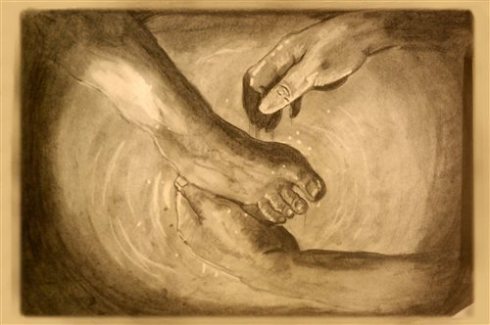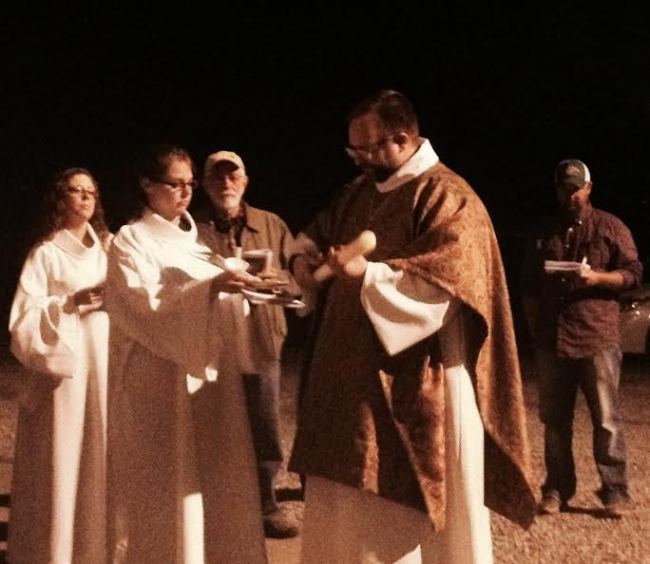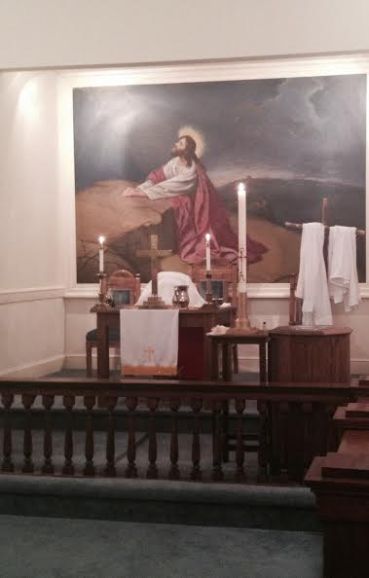The past few years have found me on a journey of wanting to learn and understand more about my faith, my Christian heritage and my Jewish heritage. As I write this post on Saturday night, I’ve just arrived home from the last of three festivals or services which were held over three days at our church. Collectively, these services are called the Holy Triduum and here’s a brief synopsis of each service and what I learned . . . about me and about the God I love.
The Maundy Thursday service is, of course, rich with symbols of Jesus’ Last Supper with his disciples. “Maundy” comes from the old Latin word meaning “command”. During this service, the story of the Last Supper that Jesus shared with his disciples when he commanded them to love one another by washing each other’s feet is retold. Jesus provides a visual lesson in teaching us to serve others. Our Lord stoops, bends and washes the feet of his disciples. I witness a grandmother and her granddaughter lovingly take turns washing each other’s feet. Dear friends who have rejoiced in each other’s good times and sorrowed together when death took loved ones to Heaven exchange loving glances as feet are washed. Many others come and participate at the foot washing station as a testimony to Amazing Love. Larry and I discussed this ritual with Adam prior to the service and both he and I exchange the act of washing each other’s feet. I view this as a time that I can thank both God and Larry for their faithfulness and steadfast love to me during the course of my life and my marriage, as well as a time of reflection. We then jointly wash Adam’s feet, to symbolize the trust we have that God knows the plans that He has for Adam’s future and that He wants us to be patient (ummm—that God wants ME to be patient—that the packing, the celebration party and Adam’s move to Wilmington, NC will come together when it NEEDS to come together).
We participate in the sacrament of Eucharist and I dip the fresh bread in the cup and when the bread meets the wine, I see His broken body and His blood. The Eucharist is such a powerful sacrament and it’s no accident that ever since I read Ann Voskamp’s book, One Thousand Gifts, that I’ve woven the word “eucharisteo” into my heart and mind. Read her vivid description:
“Eucharisteo—it comes right out of the Gospel of Luke: ‘And He took bread, gave thanks and broke it, and gave it to them…’ (Luke 22:19 NIV). In the original language, ‘He gave thanks’ reads ‘eucharisteo.’
The root word of eucharisteo is charis, meaning ‘grace.’ Jesus took the bread and saw it as grace and gave thanks. He took the bread and knew it to be gift and gave thanks. Eucharisteo, thanksgiving, envelopes the Greek word for grace, charis. But it also holds its derivative, the Greek word chara, meaning ‘joy.’
Charis. Grace. Eucharisteo. Thanksgiving. Chara. Joy.
Deep chara joy is found only at the table of the euCHARisteo; the table of thanksgiving. The holy grail of joy, God set it in the very center of Christianity.”
There is no benediction at the end of the Maundy Thursday service. Rather, the chancel is stripped—and everything is draped in black burlap. The Son of God has begun the dark journey to the cross. As the black burlap is draped over the cross, I think of the blackness—the darkness—that I would still be in, if I did not know Him.
The Good Friday service is somber and the silenced church makes me wonder what the disciples were thinking on this day. The “Shadows” liturgy describes Jesus’ journey to Golgotha. Scripture takes us through Jesus’ shadows of abandonment when the disciples fell asleep in the Garden of Gethsemane, of betrayal when Judas betrays Jesus with a kiss, of accusation when Jesus appears before the Sanhedrin, of Peter’s denial, of the injustice imposed by Pilate, of the mockery by the soldiers, of Jesus’ death and, finally, of His burial. We walk silently through the twelve stations of the Cross and read the Scripture at each station. No words are spoken and we exit in silence. Emptiness is the theme that I hear in the silence. The bulletin contains this prayer to sustain us through the silence–through all the silences of our journey:
Lord, You have always given bread for the coming day; and though I am poor, today I believe.
Lord, You have always given strength for the coming day; and though I am weak, today I believe.
Lord, You have always given peace for the coming day; and though of anxious heart, today I believe.
Lord, You have always kept me safe in trials; and now, tried as I am, today I believe.
Lord, You have always marked the road for the coming day; and though it may be hidden, today I believe.
Lord, You have always lightened this darkness of mine; and though the night is here, today I believe.
Lord, You have always spoken when time was ripe; and though you be silent now, today I believe.
Saturday brings the Easter Vigil and this service finds its roots in the Old Testament and relives in ritual, the night the Israelites stayed awake waiting for God to deliver them from their slavery in Egypt. Similarly, since days begin at dusk in the Bible, we gather on this pleasantly warm Saturday night to celebrate Jesus’ victory over death by recounting the entire story of God’s salvation from Creation to New Creation. We begin the service outside the church around a fire and proceed inside to the dark sanctuary with our candles lit. We’re carrying a light, but not just any light—it is symbolic of the Light who came to dispel the darkness. “When Jesus spoke again to the people, He said, “I am the light of the world. Whoever follows me will never walk in darkness, but will have the light of life.” (John 8:12 NIV)
The Christ Candle
Christ yesterday and today…the beginning and the end…Alpha…and Omega…
all time belongs to Him…and all the ages…to Him be glory and power…through every age forever. Amen.
I listen to one of the lectors read the story of Abraham as he sojourned up a mountain in the region of Moriah with Isaac by his side. He walks in obedience; he takes each difficult step with trust. Abraham reaches the destination where he will sacrifice Isaac on the altar and then God provides the lamb. Much later, God provides another Lamb for humankind. Someone sent me this picture taken at the Easter Vigil after Adam and I had participated in Eucharist, and, while it is a moment that I could have chosen to remain private, it illustrates the point that Jesus died on the cross for us all—for people of all ages, nations and races. He loves us all.
Four letters sum up three days full of symbols—LOVE.
What if I could speak all languages of humans and of angels? If I did not love others, I would be nothing more than a noisy gong or a clanging cymbal. (1 Corinthians 13:1)
As I move from Easter Sunday into Monday and, frankly, the remainder of my life, my hope is that I will be a symbol of His love instead of a clanging cymbal.
Heartfelt gratitude to our Pastor, our Pianist, our Lectors and to all folks behind the scenes who
made The Holy Triduum such a meaningful and rich experience.
Sunrise Service on April 20, 2014
Peter said, “I really am learning that God doesn’t show partiality to one group of people over another.
Rather, in every nation, whoever worships Him and does what is right is acceptable to Him.
This is the message of peace He sent to the Israelites by proclaiming the good news through Jesus Christ:
He is Lord of all!”
Acts 10:34-36 (CEB)










